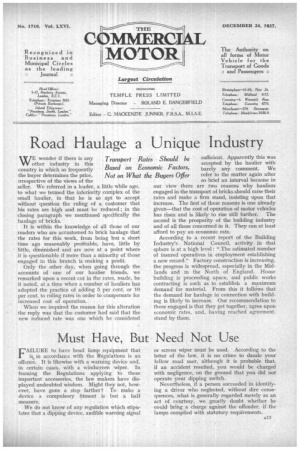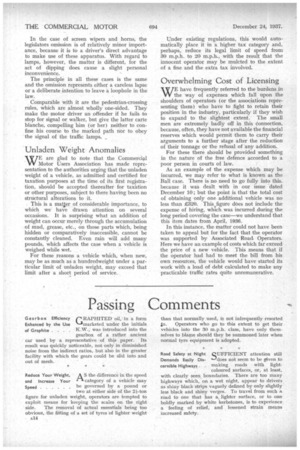Must Have, But Need Not Use
Page 1

Page 2

If you've noticed an error in this article please click here to report it so we can fix it.
CAILURE to have head lamp equipment that is, in accordance with the Regulations is an offence. It is likewise with a warning device and, in certain cases, with a windscreen wiper. In framing the Regulations applying to these important accessories, the law makers have displayed undoubted wisdom. Might they not, however, have gone a step farther? To make a device a compulsory fitment is but a half measure. • We do not know of any regulation which stipulates that a dipping device, audible warning signal or screen wiper must be used. According to the letter of the law, it is no crime to dazzle your fellow road user, although it is probable that, if an accident resulted, you would be charged with negligence, on the ground that you did not operate your dipping switch.
Nevertheless, if a person succeeded in identifying a driver who neglected, without dire consequences, what is generally regarded merely as an act of courtesy, we greatly doubt whether he could bring a charge against the offender, if the lamps complied with statutory requirements. In the case of screen wipers and horns, the legislators omission is of relatively minor importance, because it is to a driver's direct advantage to make use of these apparatus. With regard to lamps, however, the matter is different, for the act of dipping does cause a slight personal inconvenience. • The principle in all these cases is the same and the omission represents either a careless lapse or a deliberate intention to leave a loophole in the law.
Comparable with it are the pedestrian-crossing rules, which are almost wholly one-sided. They make the motor driver an offender if he fails to stop for signal or walker, but give the latter carte blanche, compelling him (or her) neither to confine his course to the marked path nor to obey the signal of the traffic lamps.
Unladen Weight Anomalies
WE are glad to note that the Commercial Motor Users Association has made representation to the authorities urging that the unladen weight of a vehicle, as admitted and certified for taxation purposes at the time of its first registration, should be accepted thereafter for taxation or other purposes, subject to there having been no structural alterations to it.
This is a matter of considerable importance, to which we have drawn attention on several occasions. It is surprising what an addition of weight can occur merely through the accumulation of mud, grease, etc., on those parts which, being hidden or comparatively inaccessible, cannot be constantly cleaned. Even rain will add many pounds, which affects the case when a vehicle is weighed while wet. .
For these reasons a vehicle which, when new, may be as much as a hundredweight under a particular limit of unladen weight, may exceed that limit after a short period of service. Under existing regulations, this would automatically place it in a higher tax category and, perhaps, reduce its legal limit of speed from 30 m.p.h. to 20 m.p.h., with the result that the innocent operator may be mulcted to the extent of a fine and the extra tax involved.
Overwhelming Cost of Licensing
WE have frequently referred to the burdens in the way of expenses which fall upon the shoulders of operators (or the associations representing them) who have to fight to retain their position in the industry, particularly if they wish to expand to the slightest extent. The small men are extremely badly off in this Connection, because, often, they have not available the financial reserves which would permit them to carry their arguments to a further stage after the reduction of their tonnage or the refusal of any addition.
For these there should be provided .something in the nature of the free defence accorded to a poor person in courts of law.
As an example of the expense which. may be incurred, we may refer to what is known as the Ball case. There is no need to go fully into this, because it was dealt with in our issue dated December 10; but the point is that the total cost of obtaining only one additional vehicle was no less than £320. Thistfigure does not include the expense of hiring, which was incurred during the long period covering the case—we understand that this item dates from April, 1936.
In this instance, the matter could not have been taken to appeal but for the fact that the operator was supported by Associated Road. Operators. Here we have an example of costs which far exceed the price of a new vehicle. This means that if the operator had had to meet the bill from his own resources, the vehicle would have started its work with a load of debt calculated to make any practicable traffic rates quite unremumrative.


























